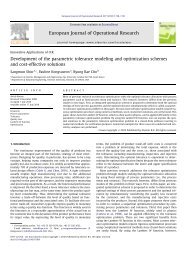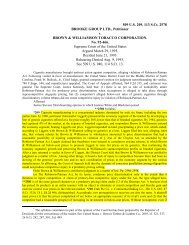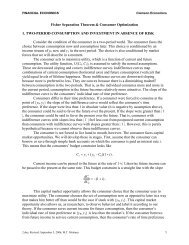A comparative discrete-dislocation/nonlocal crystal-plasticity
A comparative discrete-dislocation/nonlocal crystal-plasticity
A comparative discrete-dislocation/nonlocal crystal-plasticity
You also want an ePaper? Increase the reach of your titles
YUMPU automatically turns print PDFs into web optimized ePapers that Google loves.
typeset2:/sco3/jobs1/ELSEVIER/msa/week.17/Pmsa15088y.001 Wed May 16 07:53:37 2001 Page Wed<br />
8<br />
D. Columbus, M. Grujicic / Materials Science and Engineering A000 (2001) 000–000<br />
<br />
necessary <strong>dislocation</strong>s, s G. The following function for s<br />
is chosen:<br />
s 1<br />
k k =[(s S) +(s G) ] k (22)<br />
because it ensures that s s S whenever s S sG and<br />
that s s G whenever s S sG . Two values of k are<br />
generally investigated in the literature: (a) k=1 which<br />
corresponds to a superposition of the contributions of<br />
statistically stored and geometrically necessary <strong>dislocation</strong>s<br />
to the slip resistance; and (b) k=2 which, since<br />
slip resistance scales with a square root of <strong>dislocation</strong><br />
density, corresponds to a superposition of the densities<br />
of the two types of (statistically stored and geometrically<br />
necessary) <strong>dislocation</strong>s. In the present work however,<br />
only case (a), k=1, was considered.<br />
The evolution of the component of the slip system<br />
resistance associated with statistically stored <strong>dislocation</strong>s<br />
is taken to evolve as:<br />
s S= h (23)<br />
where h is an element of the matrix which describes<br />
the rate of strain hardening on the slip system due to<br />
shearing on the coplanar (self-hardening) and noncoplanar<br />
(latent-hardening) slip systems . Eq. (23) is<br />
often used within the framework of local <strong>crystal</strong> <strong>plasticity</strong>,<br />
e.g. Refs. [19,20]. Following Anand and coworkers<br />
[19,20], the following simple form for the h element of<br />
the slip system hardening matrix is adopted:<br />
h =q h (no summation on )<br />
Here, h denotes the single-slip hardening rate while<br />
q is a matrix describing the latent hardening behavior.<br />
Following Anand and coworkers [19,20], the matrix<br />
q and the single-slip hardening rate h are given as:<br />
q 1<br />
=<br />
q1=1.4 if and are coplanar slip systems<br />
otherwise<br />
(25)<br />
and<br />
h <br />
=h s S<br />
0 1− (26)<br />
s 1 r<br />
where, h 0, the initial hardening rate, s 1, the saturation<br />
slip resistance, and exponent r are respectively set equal<br />
for both slip systems (h 1 0=h 2 0, s 1 1=s 2 1).<br />
The component of the slip resistance arising from the<br />
presence of geometrically necessary <strong>dislocation</strong>s, s G,is assumed to be given by the following phenomenological<br />
equation [10]:<br />
s G=cbn G (27)<br />
where is the shear modulus, b the magnitude of the<br />
Burger’s vector, c a constant (set to 0.3 in accordance<br />
with Ashby [21]), and n G is the density of point obstacles<br />
(forest <strong>dislocation</strong>s) associated with geometrically<br />
necessary <strong>dislocation</strong>s. The short-range slip resistance<br />
arising from these point obstacles is a strong function<br />
of the type of <strong>dislocation</strong> junctions formed between<br />
mobile <strong>dislocation</strong>s on a given slip system and the<br />
forest <strong>dislocation</strong>s. Following Franciosi and co-workers<br />
[22,23], the dependence of the obstacle strength on the<br />
type of <strong>dislocation</strong> interaction is introduced through a<br />
set of interaction coefficients a . Consequently, the<br />
density of point obstacles, n G , can be expressed as:<br />
n G= a G (28)<br />
It is well established, e.g. Ref. [10], that the density of<br />
geometrically-necessary <strong>dislocation</strong>s scales with the<br />
Nye’s <strong>dislocation</strong> tensor, the tensor which is a measure<br />
of the tensorial curl of FP . Following the procedure<br />
proposed by Dao and Parks [10], which is briefly<br />
overviewed in the Appendix, an evolution equation for<br />
the density of geometrically necessary <strong>dislocation</strong>s associated<br />
with each slip system, under the plane-strain<br />
condition, is derived as:<br />
1 d<br />
G= +F21 )]<br />
[ bp 0(3) dx2 P (F 11n<br />
0(1)<br />
− d<br />
[<br />
dx1 P P (F 12n<br />
0(1) +F22n<br />
0(2)<br />
P n 0(2)<br />
)] (29)<br />
where n 0(1) and n 0(2) are components of the slip plane<br />
normal n 0, and p 0(3) is a component of p 0, a vector<br />
defined as p 0=m 0×n 0. The geometrically necessary<br />
<strong>dislocation</strong>s are of the edge character, with their line<br />
directions parallel to the x3-axis and their Burgers<br />
vectors collinear with the corresponding slip direction<br />
m 0.<br />
The stress strain relationship, Eq. (16), the flow rule,<br />
Eq. (20), and the evolution equations for the slip resistance<br />
due to statistically stored <strong>dislocation</strong>s, Eq. (23),<br />
and for the geometrically-necessary <strong>dislocation</strong>s, Eq.<br />
(27), constitute the non-local <strong>crystal</strong>-<strong>plasticity</strong> material<br />
constitutive model. The integration of the model along<br />
the loading path is carried out within the User Material<br />
Subroutine (UMAT) of Abaqus/Standard. With the<br />
exception of the density of geometrically-necessary <strong>dislocation</strong>s,<br />
all other material state variables are integrated<br />
using a forward Euler approach. Since the<br />
integration of the density of geometrically necessary<br />
<strong>dislocation</strong>s requires the computation of the gradient of<br />
state variables, which in turn depends on the material<br />
state at surrounding integration points, a backward<br />
Euler integration scheme was used to update G. Since<br />
the same integration scheme has been applied in a<br />
number of our recent studies, e.g. Ref. [24] it will not be<br />
discussed here.<br />
UNCORRECTED PROOF
















